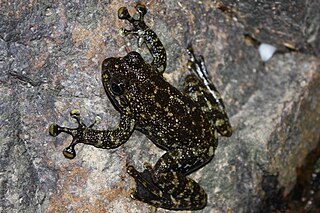
The Hong Kong Zoological and Botanical Gardens is one of the oldest zoological and botanical centres in the world, and the oldest park in Hong Kong. Founded in 1864, its first stage was opened to the public in 1871. It occupies an area of 5.6 hectares, in Central, on the northern slope of Victoria Peak.

Mount Parker is the second-highest peak on Hong Kong Island, after Victoria Peak. It is the 40th-highest peak in the territory of Hong Kong.
This list contains species first discovered in Hong Kong, with the endemic species asterisked.

The Hong Kong warty newt or Hong Kong newt is a species of salamander found in Hong Kong. Once thought to be endemic to the territory, the species has also been found in the coastal parts of Guangdong Province. It is the only Urodela living in Hong Kong.

Hong Kong cascade frog or Hong Kong torrent frog is a species of true frog from southern coastal China, once thought to be endemic to Hong Kong. Their eggs are laid on rock faces in the splash zones of cascades. In Hong Kong, it is a protected species under Wild Animals Protection Ordinance Cap 170.

Camellia hongkongensis, the Hong Kong camellia, is a species of camellia.

Mount Nicholson is a 430 m (1,411 ft) tall mountain located in Wan Chai District, on Hong Kong Island, Hong Kong. The hill is believed to be named for Hong Kong Volunteer Corps Adjunct Lieutenant W.C.A. Nicholson.

Paramesotriton, also known as warty newts or Asian warty newts, is a genus of salamanders in the family Salamandridae. The genus is found in southwestern and southern China and in northern Vietnam. Most of the species are endemic to China, and the majority of them have been described recently, since 2008. The genus includes both pond and stream dwellers.
Kaliella hongkongensis is a species of air-breathing land snails or semi-slugs, terrestrial pulmonate gastropod mollusks in the family Chronidae.

Thismia is a genus of myco-heterotrophic plants in family Burmanniaceae, first described as a genus in 1845. It is native to East and Southeast Asia, New Guinea, Australia, New Zealand, and the Americas.

Cornus hongkongensis is a species of evergreen dogwood native to China, Laos, and Vietnam. It grows to 15 meters in height and blooms in late spring to early summer, exhibiting an abundance of fragrant flowers. Because this species of dogwood also exhibits a range of minor differences in morphology due largely to geographic distribution, it has been divided into a number of subspecies. It has been described as an excellent ornamental tree species.
PhytoKeys is a peer-reviewed, open-access online and print botanical journal. Its stated goal is "to support free exchange of ideas and information in systematic botany".
Scaeosopha hongkongensis is a species of moth of the family Cosmopterigidae. It is found in China.

Macropodus hongkongensis is a species of paradise fish (Macropodus) endemic to southern China. This species was first discovered in Hong Kong, but later was found in other areas of southern China. It is found in mountainous regions as well as lowland habitats. This species grows to a length of more than 10 cm.
The Hong Kong oyster, is a species of true oyster found in Hong Kong and the mouth of Pearl River in China. The species was uniquely identified by comparing the genetic distances of mitochondrial DNA sequences. The species has a long cultivation history for over 700 years. It is a sister taxon of Magallana nippona.
Limimaricola hongkongensis is a Gram-negative, non-spore-forming, short rod-shaped and non-motile bacterium from the genus of Limimaricola which has been isolated from biofilm from Hong Kong.

Hemiphyllodactylus hongkongensis, also known as the Hong Kong slender gecko, is a species of gecko. It is endemic to Hong Kong.
Athetis hongkongensis, the Hong Kong marsh moth is a noctuid moth found in Hong Kong. The species was first described by Anthony Galsworthy in 1997.
Christensenella hongkongensis is a species of clinically relevant gram-positive coccobacilli, first isolated from patients in Hong Kong and Canada in 2006. Although the species remains relatively rare, it has a high mortality rate of up to 50%. Christensenella is thought to be broadly distributed globally, as it has been isolated from patient blood cultures around the world including Hong Kong, South Korea, New Zealand, Canada, Sweden, France and Italy. Fewer than 15 cases of C. hongkongensis have been observed worldwide.










